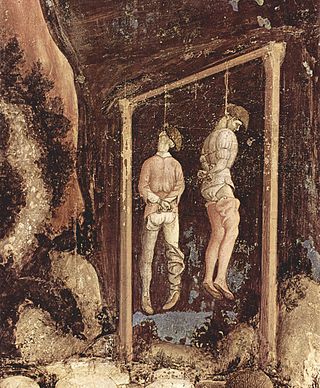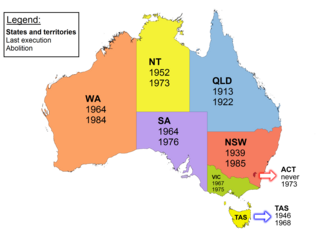Related Research Articles

Hanging is killing a person by suspending them from the neck with a noose or ligature. Hanging has been a common method of capital punishment since the Middle Ages, and is the primary execution method in numerous countries and regions. The first known account of execution by hanging is in Homer's Odyssey. Hanging is also a method of suicide.

Albert Pierrepoint was an English hangman who executed between 435 and 600 people in a 25-year career that ended in 1956. His father Henry and uncle Thomas were official hangmen before him.

Capital punishment in the United Kingdom predates the formation of the UK, having been used within the British Isles from ancient times until the second half of the 20th century. The last executions in the United Kingdom were by hanging, and took place in 1964; capital punishment for murder was suspended in 1965 and finally abolished in 1969. Although unused, the death penalty remained a legally defined punishment for certain offences such as treason until it was completely abolished in 1998; the last execution for treason took place in 1946. In 2004 the 13th Protocol to the European Convention on Human Rights became binding on the United Kingdom; it prohibits the restoration of the death penalty as long as the UK is a party to the convention.

Capital punishment is a legal penalty in the U.S. state of Ohio, although all executions have been suspended indefinitely by Governor Mike DeWine until a replacement for lethal injection is chosen by the Ohio General Assembly. The last execution in the state was in July 2018, when Robert J. Van Hook was executed via lethal injection for murder.
The U.S. state of Washington enforced capital punishment until the state's capital punishment statute was declared null and void and abolished in practice by a state Supreme Court ruling on October 11, 2018. The court ruled that it was unconstitutional as applied due to racial bias however it did not render the wider institution of capital punishment unconstitutional and rather required the statute to be amended to eliminate racial biases. From 1904 to 2010, 78 people were executed by the state; the last was Cal Coburn Brown on September 10, 2010. In April 2023, Governor Jay Inslee signed SB5087 which formally abolished capital punishment in Washington State and removed provisions for capital punishment from state law.

Capital punishment was abolished via the legislative process on May 2, 2013, in the U.S. state of Maryland.
Capital punishment in Canada dates back to Canada's earliest history, including its period as a French colony and, after 1763, its time as a British colony. From 1867 to the elimination of the death penalty for murder on July 26, 1976, 1,481 people had been sentenced to death, and 710 had been executed. Of those executed, 697 were men and 13 were women. The only method used in Canada for capital punishment of civilians after the end of the French regime was hanging. The last execution in Canada was the double hanging of Arthur Lucas and Ronald Turpin on December 11, 1962, at Toronto's Don Jail. The military prescribed firing squad as the method of execution until 1999, although no military executions had been carried out since 1946.
Capital punishment was abolished in 2019 in New Hampshire for persons convicted of capital murder. It remains a legal penalty for crimes committed prior to May 30, 2019.

Capital punishment in India is a legal penalty for some crimes under the country's main substantive penal legislation, the Indian Penal Code, as well as other laws. Executions are carried out by hanging as the primary method of execution as given under Section 354(5) of the Criminal Code of Procedure, 1973 is "Hanging by the neck until dead", and is imposed only in the 'rarest of cases'.

Capital punishment – the process of sentencing convicted offenders to death for the most serious crimes and carrying out that sentence, as ordered by a legal system – first appeared in New Zealand in a codified form when New Zealand became a British colony in 1840. It was first carried out with a public hanging in Victoria Street, Auckland in 1842, while the last execution occurred in 1957 at Mount Eden Prison, also in Auckland. In total, 85 people have been executed in New Zealand.
James Berry was an English executioner from 1884 until 1891. Berry was born in Heckmondwike in the West Riding of Yorkshire, where his father worked as a wool-stapler. His most important contribution to the science of hanging was his refinement of the long drop method developed by William Marwood, whom Berry knew quite well. His improvements were intended to diminish mental and physical suffering and some of them remained standard practice until the abolition of capital punishment for murder.

The use of capital punishment by the United States military is a legal punishment in martial criminal justice. Despite its legality, capital punishment has not been imposed by the U.S. military in over sixty years.
Alfred Porter Southwick was a steam-boat engineer, dentist and inventor from Buffalo, New York. He is credited with inventing the electric chair as a method of legal execution. He was also a professor at the University of Buffalo school of dental medicine, now known as the State University of New York at Buffalo.

Capital punishment in Australia was a form of punishment in Australia that has been abolished in all jurisdictions. Queensland abolished the death penalty in 1922. Tasmania did the same in 1968. The Commonwealth abolished the death penalty in 1973, with application also in the Australian Capital Territory and the Northern Territory. Victoria did so in 1975, South Australia in 1976, and Western Australia in 1984. New South Wales abolished the death penalty for murder in 1955, and for all crimes in 1985. In 2010, the Commonwealth Parliament passed legislation prohibiting the re-establishment of capital punishment by any state or territory. Australian law prohibits the extradition or deportation of a prisoner to another jurisdiction if they could be sentenced to death for any crime.
Bartholomew Binns (1839–1911) was an English executioner from November 1883 to March 1884. When William Marwood died on 4 September 1883 after a brief illness, Binns was appointed to the position of Executioner for the City of London and Middlesex. Before becoming hangman, Binns was employed as foreman platelayer at Dewsbury by the Lancashire and Yorkshire Railway Company, but after he got the post he no longer worked anywhere.
Capital punishment in South Africa was abolished on 6 June 1995 by the ruling of the Constitutional Court in the case of S v Makwanyane, following a five-year and four-month moratorium since February 1990.

Capital punishment in Gibraltar included public execution in the nineteenth century until 1864. The last sentence of death was passed in 1952. Under British law, capital punishment was almost abolished in 1965, in line with British practice. It was entirely abolished in 2002 along with all other British Overseas Territories.
Capital punishment is a form of legal penalty in Indonesia. Although the death penalty is normally enforced only in grave cases of premeditated murder, corruption in extreme cases can lead to the death penalty and the death penalty is also regularly applied to certain drug traffickers. Executions are carried out by firing squad.
Capital punishment is a legal penalty in the U.S. state of Georgia. Georgia reintroduced the death penalty in 1973 after Furman v. Georgia ruled all states' death penalty statutes unconstitutional. The first execution to take place afterwards occurred in 1983.
References
- ↑ The process of judicial hanging Archived 2011-08-15 at the Wayback Machine
- ↑ "Hanged by the neck until dead. The process of judicial hanging".
- ↑ "Procedure For Military Executions" (PDF). Library of Congress . December 1947. Archived from the original (PDF) on 1 March 2008.